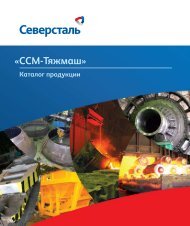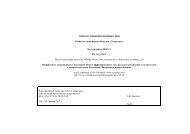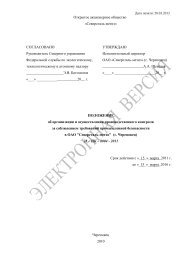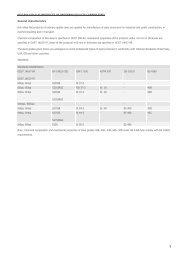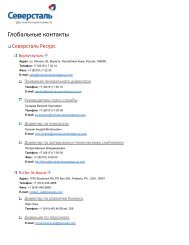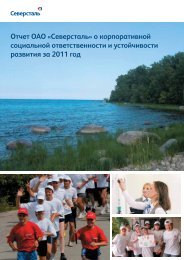Download PDF - Severstal
Download PDF - Severstal
Download PDF - Severstal
Create successful ePaper yourself
Turn your PDF publications into a flip-book with our unique Google optimized e-Paper software.
OAO <strong>Severstal</strong> and subsidiariesOAO <strong>Severstal</strong> and subsidiariesNotes to the consolidated financial statementsfor the years ended December 31, 2008, 2007 and 2006(Amounts expressed in thousands of US dollars, except as stated otherwise)Notes to the consolidated financial statementsfor the years ended December 31, 2008, 2007 and 2006(Amounts expressed in thousands of US dollars, except as stated otherwise)Deferred income tax assetsDeferred tax assets are reviewed at each balance sheet date and reduced to the extent that it is no longerprobable that sufficient taxable profit will be available to allow all or part of the deferred tax asset to be utilized.The estimation of that probability includes judgments based on the expected performance. Various factors areconsidered to assess the probability of the future utilization of deferred tax assets, including past operating results,operational plans, expiration of tax losses carried forward, and tax planning strategies. If actual results differ fromthat estimates or if these estimates must be adjusted in future periods, the financial position, results of operationsand cash flows may be negatively affected. In the event that the assessment of future utilization of deferred taxassets must be reduced, this reduction will be recognized in the income statement.Functional and presentation currencyThe presentation currency of these consolidated financial statements is the US dollar.The functional currency is determined separately for each of the Group’s entities. For all Russian entities functionalcurrency is the Russian ruble. The functional currency of the Group’s entities located in North America is the USdollar. The functional currency of the majority of the Group’s entities located in Western Europe is the Euro.The translation into the presentation currency is made as follows:• all assets and liabilities, both monetary and non-monetary, are translated at the closing exchange rates at thedates of each balance sheet presented;• all income and expenses in each income statement are translated at the average exchange rates for the periodspresented; and• all resulting exchange differences are recognized as a separate component in equity.Any conversion of amounts into US dollars should not be construed as a representation that such amounts havebeen, could be, or will be in the future, convertible into US dollars at the exchange rates used, or at any otherexchange rate.Adoption of new and revised IFRSAs of January 1, 2008, the Group has adopted three Interpretations issued by the International Financial ReportingInterpretations Committee, which are effective for the annual reporting periods beginning on or after January1, 2007. These are: IFRIC 11 “IFRS 2: Group and Treasury Share Transactions”; IFRIC 12 “Service ConcessionArrangements”; and IFRIC 14 “IAS 19 – The Limit on a Defined Benefit Asset, Minimum Funding Requirementsand their Interaction”. The adoption of these Interpretations did not affect the Group’s consolidated financialstatements.New accounting pronouncementsA number of new Standards, amendments to Standards and Interpretations were not yet effective for the year endedDecember 31, 2008, and have not been applied in these consolidated financial statements.Standards and InterpretationsEffective for annual periods beginning on or afterIAS 1 (Revised) “Presentation of Financial Statements” January 1 and July 1, 2009IAS 16 (Amended) “Property, Plant and Equipment” January 1 and July 1, 2009IAS 20 (Amended) “Accounting for Government Grants andDisclosure of Government Assistance” January 1, 2009IAS 23 (Revised) “Borrowing Costs” January 1,2009IAS 27 (Amended) “Consolidated and Separate Financial Statements” July 1, 2009IAS 28 (Amended) “Investments in Associates” January 1 and July 1, 2009IAS 31 (Amended) “Interests in Joint Ventures” January 1 and July 1, 2009IAS 32 (Amended) “Financial instruments: Presentation” January 1 and July 1, 2009IAS 36 (Amended) “Impairment of Assets” January 1 and July 1, 2009IAS 38 (Amended) “Intangible Assets” January 1 and July 1, 2009IAS 39 (Amended) “Financial Instruments: Recognition andMeasurement” January 1 and July 1, 2009IAS 40 (Amended) “Investment Property” January 1, 2009IFRS 1 (Amended) “First-time Adoption of International Financial ReportingStandards” January 1 and July 1, 2009IFRS 2 (Amended) “Share-based Payment” January 1 and July 1, 2009IFRS 3 (Revised) “Business Combinations” July 1, 2009IFRS 5 (Amended) “Non-current Assets Held for Sale and DiscontinuedOperations” January 1 and July 1, 2009IFRS 8 “Operating Segments” January 1, 2009IFRIC 13 “Customer Loyalty Programmes” July 1, 2009IFRIC 15 “Agreements for the Construction of Real Estate” January 1, 2009IFRIC 16 “Hedges of a Net Investment in a Foreign Operation” October 1, 2008IFRIC 17 “Distributions of Non-cash Assets to Owners” July 1, 2009IFRIC 18 “Transfers of Assets from Customers” July 1, 2009The adoption of the pronouncements listed above is not expected to have a significant impact on the Group’sconsolidated financial statements in future periods except for those discussed below.Revised IAS 1 Presentation of Financial Statements introduces the concept of total comprehensive income,which represents changes in equity during a period other than those changes resulting from transactions withowners in their capacity as owners. Total comprehensive income may be presented in either a single statement ofcomprehensive income (effectively combining both the income statement and all non-owner changes in equity in asingle statement), or in an income statement and a separate statement of comprehensive income. Management hasnot yet decided on the presentation format of the comprehensive income in the Group’s 2009 consolidated financialstatements.Revised IAS 23 Borrowing Costs ceases the option to expense borrowing costs and requires that an entity capitalizeborrowing costs directly attributable to the acquisition, construction or production of a qualifying asset as a partof the cost of that asset. The standard identifies the borrowing costs eligible for capitalization as those that wouldhave been avoided if the expenditure on the qualifying asset had not been made. The revised IAS 23 will becomemandatory for the Group’s 2009 consolidated financial statements and will constitute a change in accounting policyfor the Group. In accordance with the transitional provisions, the Group will apply the revised IAS 23 to qualifying112113



